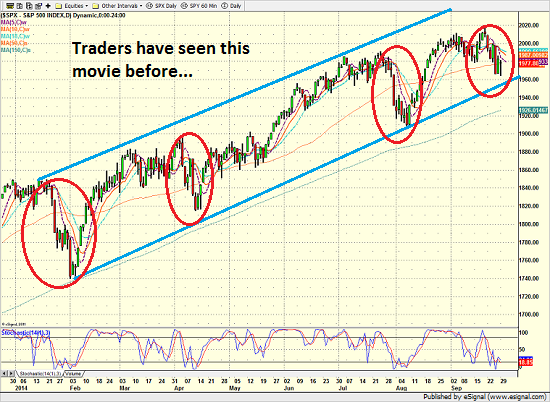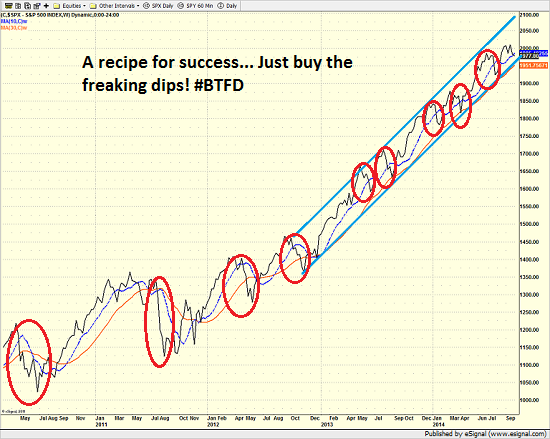Twice in the last two days, it looked like the bears were finally going to break through.
Twice in the last two days, the S&P 500 teetered on the edge. Twice in the last two days, the market came roaring back. And twice in the last two days, the bears went home disappointed.
Frankly, it has got to be frustrating to be a bear these days. For all of the talk of technical divergences, sentiment extremes, narrow leadership, geopolitical issues, social unrest and secret meetings between Fed officials and Wall Street bankers, the bears have very little to show for their efforts recently.
In fact, although the S&P 500 is in a short-term downtrend and has been below its 5, 10, and 18-day moving averages for six consecutive sessions, the venerable index is down less than 2 percent from its recent high (-1.67 percent to be exact) and still sports a gain of 7 percent on the year.
Looking around, the Dow Jones Industrial Average is off 1.21 percent from its September 19 all-time high. And the technology ladened NASDAQ Composite has fallen a whopping 2.01 percent during what is being touted as a pretty miserable September.
So what gives? Why are the major indices not being taken out behind the woodshed like their smallcap brethren? If everybody knows that the combination of narrowing leadership and technical divergences tends to be present at market tops, why is the S&P still holding up like a champ? Where is the fear? Where is the anxiety? And where is the selling?
In short, it appears that traders have seen this movie before. They've seen this scenario play out over and over and over again in the last few years. And by now, pretty much everyone knows that the hero doesn't die in the end. And everyone also knows that the battle cry to making money in this market is to "just buy the freaking dip!"
S&P 500 - Daily

The red circles are also an important part of this picture. You see, this is the fourth time in 2014 that stocks have pulled back. And how have traders responded each and every time? Yep, that's right they bought the dip.
As the next chart shows (this one is a weekly chart of the S&P), this strategy is not exactly exclusive to 2014's market. No, the #BTFD strategy has been with us for years now. And while it is interesting to note that the #BTFD opportunities have become shorter, shallower, and more frequent since the end of 2012, the dips just keep being bought.
S&P 500 - Weekly

So... while there are lots of issues in the market, unless/until the S&P 500 can break below that lower channel line - an important line in the sand that currently resides just below 1960 - traders will likely continue to... everybody now... "BUY THE FREAKING DIP!"
The problem is that this type of trading behavior can't last forever. At some point, perhaps soon, something will come along to scare traders out of the #BTFD mentality. Something will become a catalyst. Something will change the game.
So, what's it going to be? Currently traders are fretting about a host of issues including:
- The protests in Hong Kong
- The independence referendum in Catalan
- The sell-off in Brazil
- The asset flight from PIMCO
- The potential for more volatility in October
- The dollar
- Russia not playing nice
- ISIS warnings
- The Technical damage
Could any of these be the catalyst to get the bear party started? Given that yesterday morning's dip was promptly bought, it is hard to argue that any of the issues above would have the juice the bears need at this stage.
So, what is a risk manager to do? Should they just give up worrying, join the crowd and buy the dip? Probably not. However, it will be important to continue to monitor the drivers of the daily action. You just never know what traders will latch onto next!
Related Links:
© 2025 Benzinga.com. Benzinga does not provide investment advice. All rights reserved.
Trade confidently with insights and alerts from analyst ratings, free reports and breaking news that affects the stocks you care about.